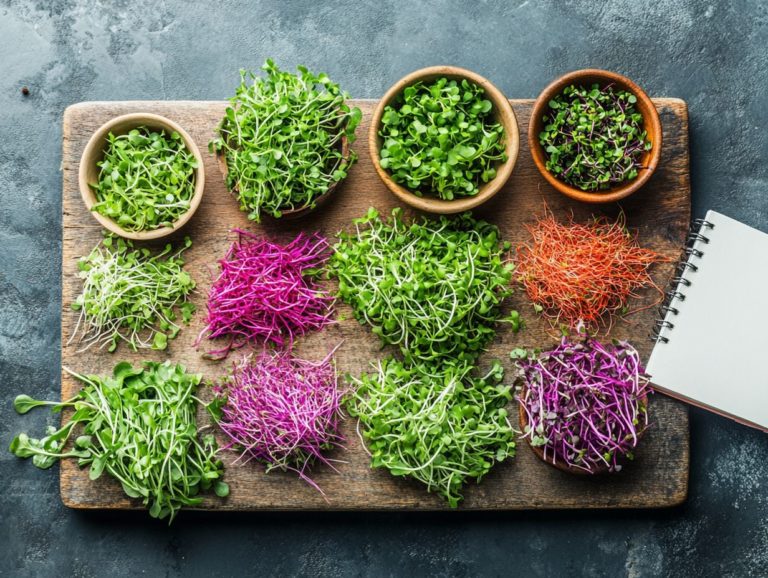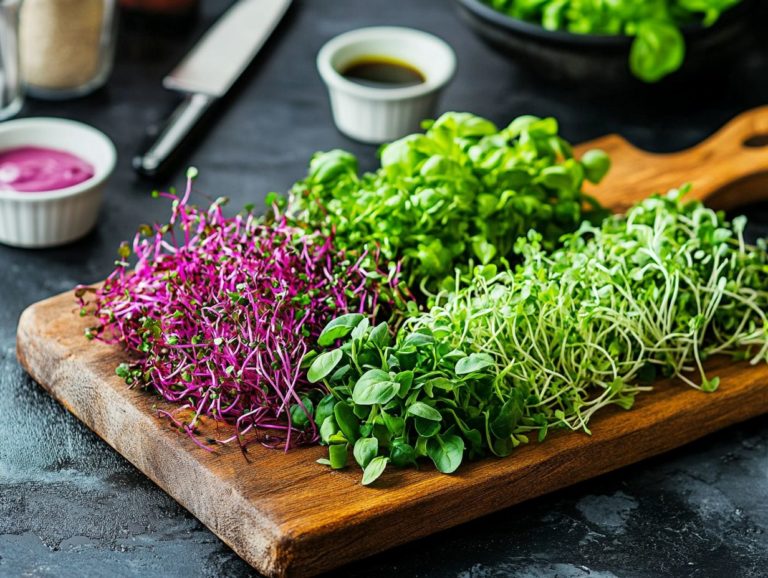5 Microgreen Varieties to Experiment With
Microgreens are miniature, flavorful plants brimming with nutrients and vibrant colors, sure to elevate any dish you create.
Consider trying out five popular microgreen varieties:
- Broccoli
- Sunflower
- Radish
- Pea
- Kale
Beyond their delightful taste, incorporating microgreens into your diet offers numerous health benefits. Get ready to uncover fun tips for growing your own microgreens at home, along with common pitfalls to avoid and smart storage techniques that will keep them fresh.
Explore how these tiny greens can make a significant impact on both your meals and overall well-being!
Contents
Key Takeaways:
- Experiment with different flavors and textures by trying out these 5 varieties of microgreens: broccoli, sunflower, radish, pea, and kale.
- Microgreens not only add a pop of color to your dishes but also offer a range of health benefits, such as high levels of vitamins and antioxidants.
- Add microgreens to your salads, sandwiches, smoothies, or even as a garnish to elevate the taste and nutritional value of your meals.
1. Broccoli Microgreens
Broccoli microgreens are a delightful and nutritious addition to your home gardening endeavors. They offer a unique flavor profile and a wealth of health benefits, making them an excellent choice for both novice and seasoned urban farmers alike.
These tiny greens are packed with vitamins A, C, and K, providing a robust antioxidant boost that helps combat cellular damage and promotes overall wellness. Their impressive levels of sulforaphane, known for its cancer-fighting properties, only add to their health allure.
Growing broccoli microgreens is super easy and incredibly rewarding! They thrive in well-drained soil and should be sown densely, with optimal seeding rates around 10-15 grams per square foot. Germination usually happens within 5 to 7 days, and as they develop, their distinct peppery flavor becomes increasingly prominent. Exploring the benefits of growing diverse microgreen varieties can further transform your salads, sandwiches, and smoothies into invigorating culinary experiences.
2. Sunflower Microgreens
Sunflower microgreens are celebrated for their delightful earthy flavor and remarkable health benefits, making them highly sought after by home gardeners and urban farming enthusiasts alike.
These vibrant greens don t just elevate your salads and sandwiches with a unique, nutty taste; they also pack a nutritional punch, rich in vitamins A, B, C, and E, along with healthy fats and proteins. For the best results, cultivate them in rich soil to maximize their flavor and nutrient profile.
Alternatively, growing plants without soil presents a space-efficient solution that encourages rapid growth. Each method brings its own advantages; soil cultivation fosters natural interactions that enhance flavor, while soil-less systems allow for precise nutrient control. This flexibility makes it an appealing choice for anyone looking to establish an urban garden or indoor farming setup.
3. Radish Microgreens
Radish microgreens bring a bold, peppery flavor that can truly elevate your culinary creations, all while offering significant health benefits. This makes them an excellent choice for anyone looking to grow microgreens at home.
These tiny greens are not simply a treat for your taste buds; they deliver a powerful nutritional boost, brimming with vitamins A, C, and K, as well as antioxidants that support your overall well-being.
To achieve optimal germination rates typically around 80% ensure a well-drained growing medium and provide adequate moisture to enhance your chances of success.
Whether you re nurturing these greens indoors or outdoors, paying attention to light and temperature is crucial for promoting robust growth. By following these care tips, you can savor the vibrant, tangy flavors and enjoy the numerous health perks that radish microgreens provide.
Ready to start your microgreen journey? Grab your seeds and get growing!
4. Pea Microgreens
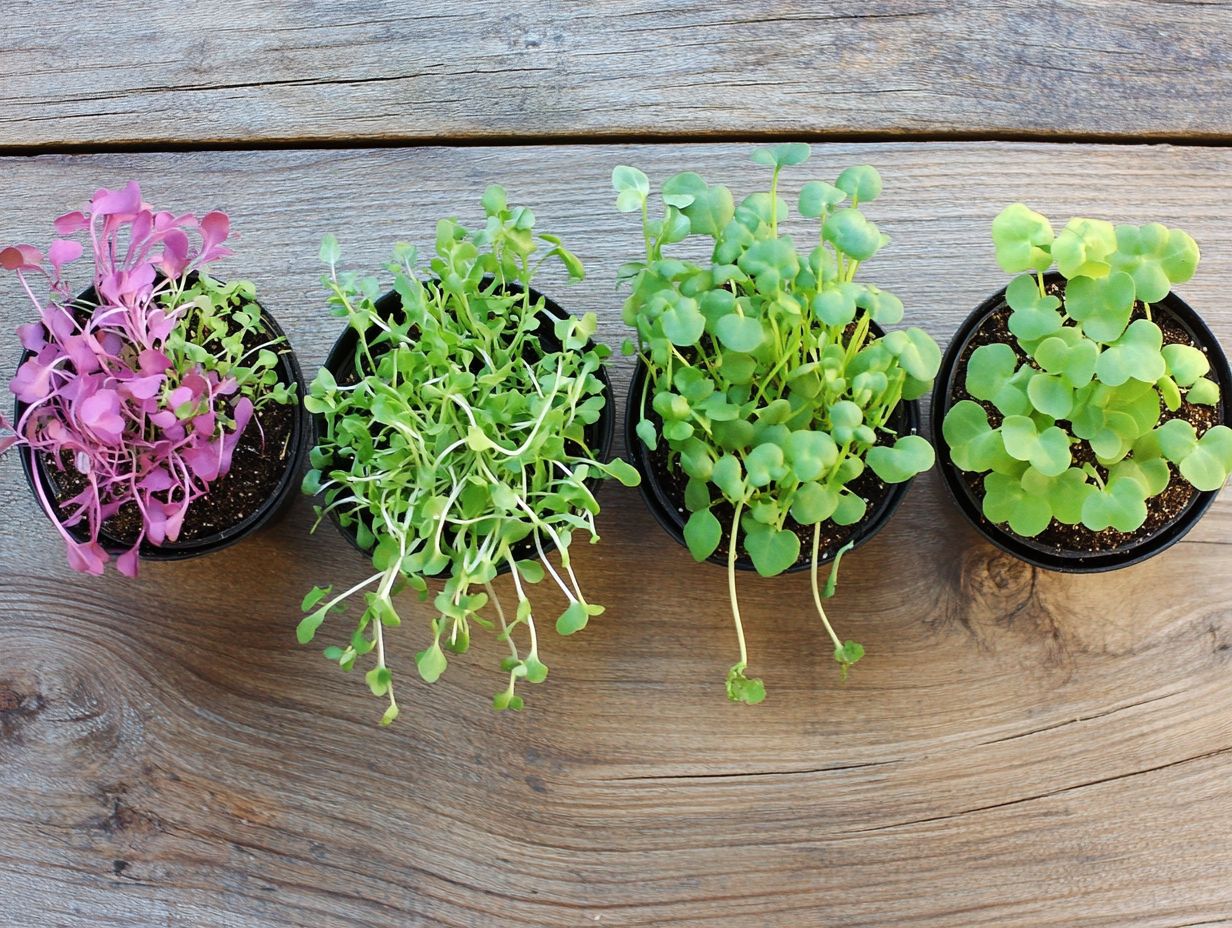
Pea microgreens offer a sweet and nutritious option for your home gardening. They are bursting with health benefits that have captured the attention of urban farming fans and cooking enthusiasts alike.
These petite greens provide a delightful sweetness reminiscent of fresh peas. They make the perfect enhancement for your salads, sandwiches, and garnishes. If you’re interested in cultivating them, check out this guide on how to grow your favorite microgreen varieties. Packed with vitamins A, C, and K, along with essential minerals, they play a vital role in boosting your immunity and promoting healthy skin.
If you’re keen on cultivating these microgreens, aim for a seeding rate of about 1 to 2 ounces per square foot. Provide the right growing conditions for optimal results. This includes a well-draining soil mix, proper moisture levels, and ample light.
5. Kale Microgreens
Kale microgreens are nutrient powerhouses that offer a vibrant flavor and numerous health benefits. They are essential for your home gardening efforts.
These tiny greens are rich in vitamins A, C, and K, along with crucial minerals like calcium and iron. They are fantastic for enhancing salads, smoothies, or sandwiches. For those looking to elevate their meals, exploring must-try microgreen varieties for salads can add a unique twist to various dishes, boosting both flavor and nutrition.
To successfully cultivate kale microgreens, selecting the right growing medium is crucial. Options like coconut coir or seed starting mix can yield impressive results. For those interested in expanding their microgreen garden, exploring seasonal microgreen varieties for year-round growth can enhance your harvest. Employ proper lighting and ensure adequate moisture for a bountiful harvest of these nutritious greens.
What Are Microgreens and Why Should You Try Them?
Microgreens are young, edible plants harvested early in their growth, rich in flavor and nutrients. They offer a wealth of health benefits and are perfect for cooking fans and home gardening enthusiasts.
These tiny greens such as arugula, basil, cilantro, and radish are not just visually appealing; they can elevate your dishes with intense flavors. Rich in vitamins A, C, and E, along with essential minerals, they serve as a nutritious boost to salads, sandwiches, soups, and garnishes. For those looking to enhance their smoothies, exploring the top 5 microgreens for smoothies is a great idea. No wonder they’ve become favorites among chefs and home cooks!
As more people embrace sustainable practices and seek fresh ingredients, the allure of growing microgreens at home continues to rise. Their diverse flavors, ranging from peppery to sweet, cater to various tastes.
What Are the Benefits of Eating Microgreens?
Eating microgreens offers numerous health benefits, boasting a rich nutrient profile and potential for disease prevention. This makes them a compelling addition to any diet focused on wellness and flavor enhancement.
These tiny greens are packed with essential vitamins like C, E, and K, along with vital minerals such as calcium and magnesium. They can significantly boost your daily nutrient intake. Varieties like arugula, with its delightful peppery bite, and radish microgreens, known for their crisp and spicy notes, not only enhance your culinary creations but also contribute positively to your overall health.
Kale microgreens are celebrated for their high antioxidant content, helping protect the body from damage, while sunflower microgreens bring a nutty flavor and a wealth of vitamin D to the table. By incorporating these vibrant greens into your meals, you can transform an everyday dish into a nutritious powerhouse. To enhance your gardening experience, learn how to choose microgreen varieties for your garden and try growing your own microgreens today!
How Can You Incorporate Microgreens into Your Diet?
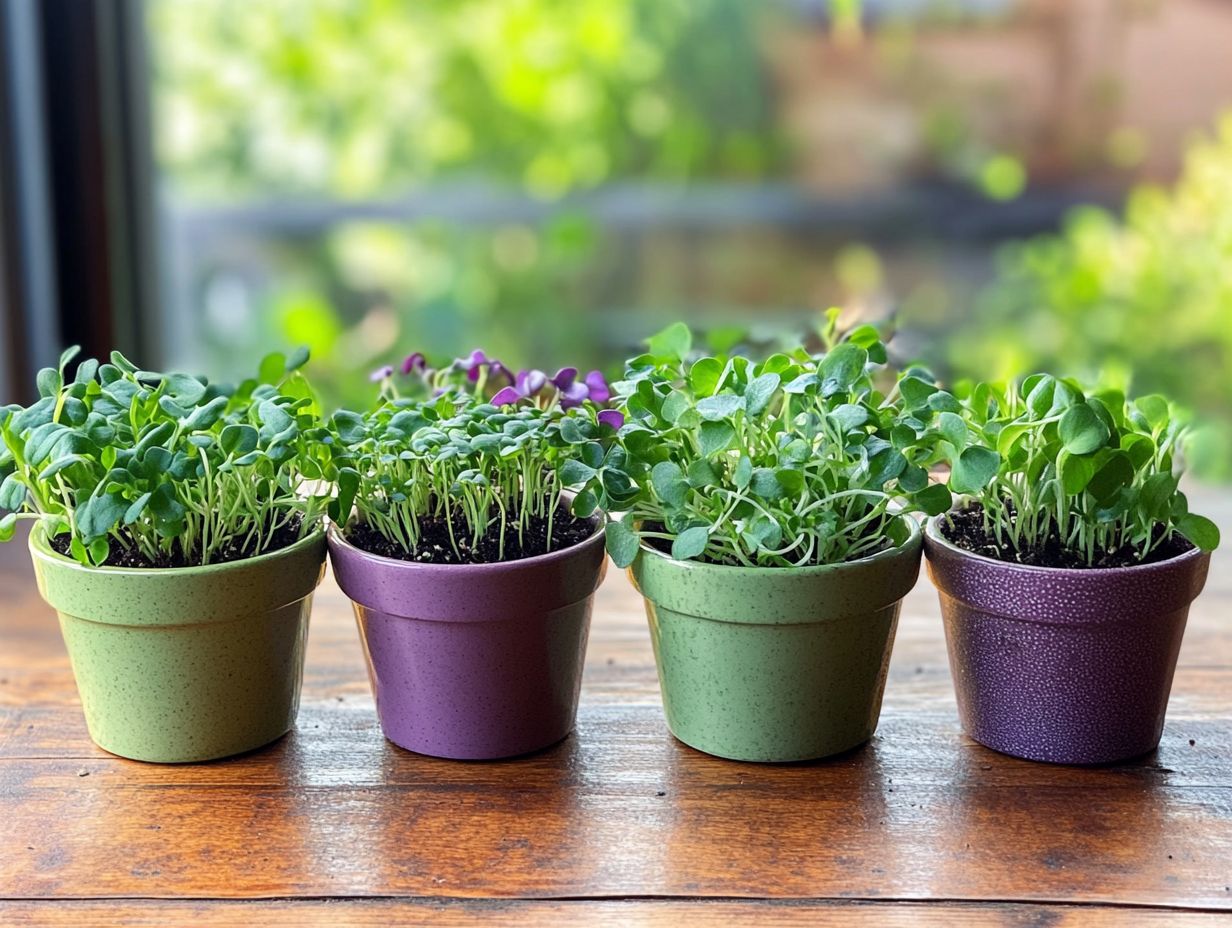
Incorporating microgreens into your diet can elevate your meals with fresh flavors and enhanced nutrition. They offer a versatile range of culinary uses, from vibrant salads to elegant garnishes.
These tiny plants burst with flavors from peppery to sweet. They can transform any dish effortlessly. For example, imagine the zesty kick spicy radish microgreens would bring to your tacos. Mild pea shoots could provide a delightful contrast in your pasta creations, and you can explore various options in the microgreen varieties: taste and flavor guide.
In terms of health benefits, these nutrient-packed greens shine with their abundance of vitamins A, C, and E. They make an exceptional addition not just for taste, but for your overall wellness. You can even experiment by blending them into smoothies for a nutritional boost that won’t compromise flavor. Plus, incorporating microgreens into your homemade dressings introduces an exciting twist to your favorite recipes. For more information, check out this quick guide to common microgreen varieties.
What Are the Different Ways to Grow Microgreens?
You have various methods to grow microgreens, from hydroponic techniques to traditional soil cultivation. Each has specific seeding and germination rates tailored for optimal success.
Your choice between these methods can impact the growth process and the eventual yield significantly. Hydroponic systems use water packed with nutrients, facilitating faster germination and denser plant growth due to better nutrient absorption. Soil-based approaches bring forth beneficial microbial activity, enhancing the flavor and nutrition of your microgreens.
Hydroponics typically requires fewer seeds per tray because of the controlled environment. Soil methods often need a higher density to ensure adequate coverage. The ideal growing mediums also differ; hydroponics usually uses alternatives like coconut coir or rock wool, while traditional soil mixes, rich in organic matter, nurture seedling root development more naturally.
What Are the Common Mistakes When Growing Microgreens?
Many enthusiasts stumble into mistakes when growing microgreens, such as incorrect watering, inadequate lighting, or poor growing mediums. These issues can significantly impede cultivation success.
These blunders can lead to frustrating outcomes, dampening the excitement of what should be a rewarding gardening journey. To sidestep these challenges, it’s crucial to establish a consistent watering schedule that keeps the growing medium moist without tipping into waterlogged territory.
Finding the perfect spot with plenty of natural light can greatly boost your microgreens! Investing in quality grow lights can also enhance both the growth rate and the overall quality of your microgreens. Select a nutrient-rich growing medium for essential support during development.
By embracing these best practices, you can cultivate healthy, vibrant microgreens that offer remarkable flavors and impressive nutritional benefits.
How Can You Store and Preserve Microgreens?
To keep your microgreens fresh, act quickly! Storing and preserving them properly is essential for maintaining their freshness, flavor, and nutritional value. This ensures you maximize the benefits of your home gardening efforts.
Use a cool, dark place ideally in the refrigerator. Use a breathable container lined with a damp paper towel to soak up extra moisture and prevent spoilage. You might consider using a resealable bag or a glass jar, as these options can significantly extend their freshness. Remember to avoid washing your microgreens until just before you re ready to use them to retain their natural nutrients and flavors.
If you want to store them for an extended period, freezing microgreens in small batches is a great strategy, allowing you to enjoy their vibrant taste weeks later. For culinary professionals, exploring microgreen varieties can enhance your dishes even further.
Frequently Asked Questions
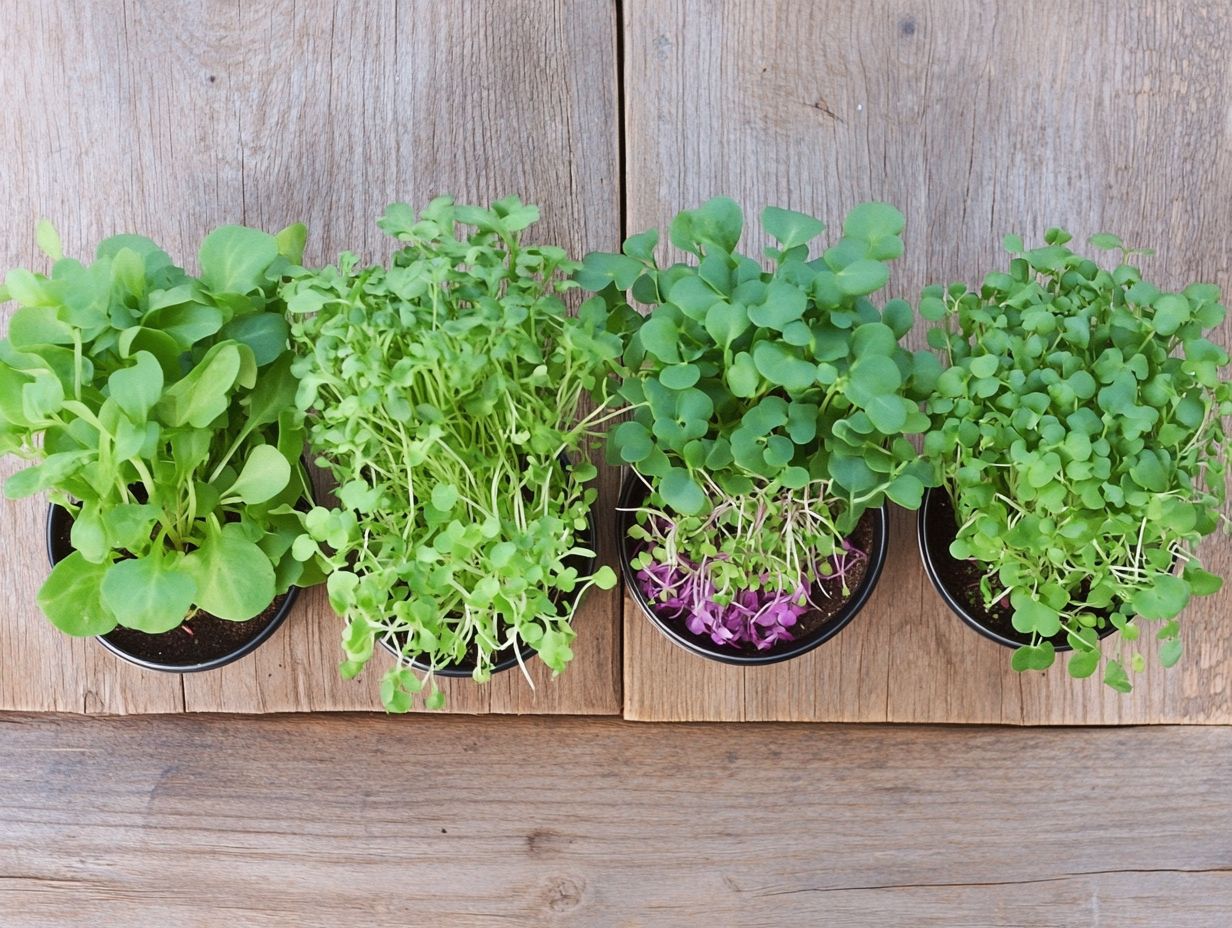
What are microgreens?
Discover the vibrant world of microgreens young, edible seedlings bursting with flavor! They are packed with nutrients and known for their intense taste and vibrant colors.
Why should I experiment with microgreens?
Adding microgreens to your meals boosts flavor and nutrition. It also lets you try new varieties and find your favorites.
What are the best microgreen varieties to experiment with?
The 5 best microgreen varieties to experiment with are broccoli, radish, sunflower, pea shoots, and red cabbage. They are simple to grow and provide exciting flavors and colors.
How do I grow microgreens?
Ready to grow your own microgreens? Start with a shallow tray and fill it with potting soil. Sprinkle your seeds on top, cover lightly, and water them regularly.
Place your tray in a sunny spot, and watch them thrive! They ll be ready for harvest in just a few weeks.
What are the flavor profiles of these microgreen varieties?
Broccoli microgreens offer a mild sweetness that delights your palate. Radish microgreens pack a spicy punch, while sunflower microgreens bring a nutty richness. Pea shoot microgreens provide a fresh and sweet taste, and red cabbage microgreens have a slightly sweet and tangy flavor.
How do I incorporate microgreens into my meals?
Microgreens can be used in a variety of ways, such as adding them to salads, sandwiches, soups, or smoothies. They make excellent garnishes for main dishes and can be used as toppings for pizzas or mixed into omelets for an extra burst of flavor and nutrition.
Why wait? Dive into your microgreen journey today and elevate your meals!

